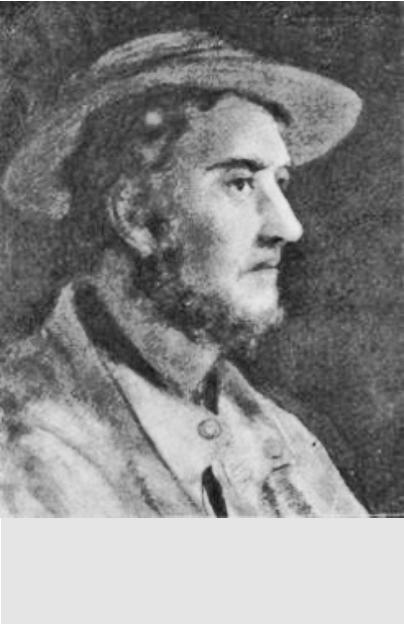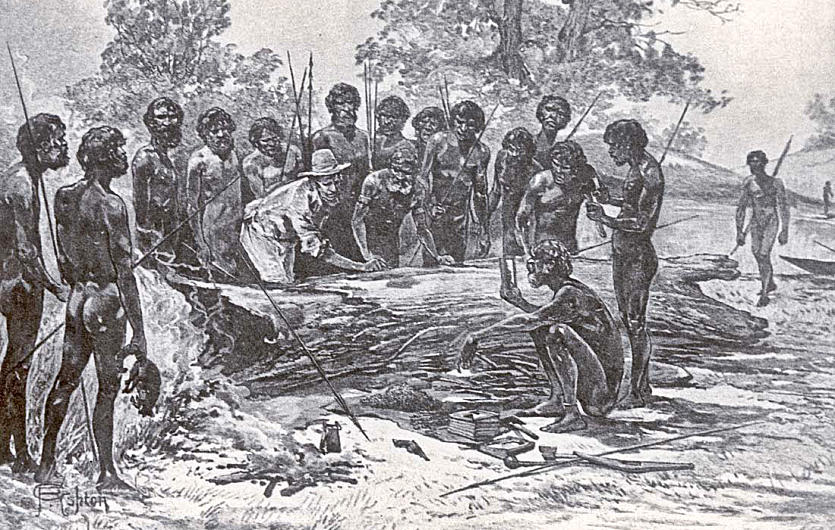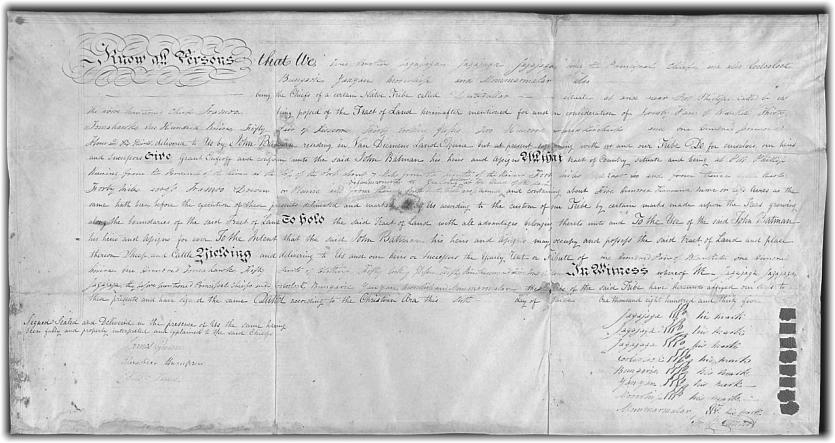In his long life Thomas Massey associated with many
interesting people. One who was worthy of a chapter to
himself was his neighbour John Batman.
Example Text Extract - John Batman
From Convict to Chief Constable
The story of Thomas Massey, by Rutherford J Browne

16. JOHN BATMAN - MELBOURNE
Most Australians have heard of John Batman and his role in the establishment of Melbourne. Most believe he took advantage of a naive people and purchased valuable land for a few tools and trinkets. Nothing is further from the truth. Batman was a complex character and on balance tried to deal fairly with his fellow man. He understood the indigenous peoples concept that land itself could not be sold, but that the right to share in its usage was a valuable commodity in the hands of those who controlled it. The district Elders (Chiefs) knew exactly what they were doing and they drove a fair, but hard, bargain. A white man, William Buckley, had been living in their midst for 32 years. Buckley was trusted and respected by the local tribes and in some ways this eased Batman’s task. Batman actually paid for an option to graze cattle and sheep on a pre- agreed area of land for a pre- agreed annual lease payment. In the process he put the Colonial Government in a very difficult legal position.Batman and Massey
Thomas Massey and John Batman were very well acquainted. Ellerslie was in effect the gateway to Batman’s property. The name given to Batman’s combined grants was Kingston. They lay some 10km (6 miles) up the track that followed the Ben Lomond Rivulet, from Ellerslie, upstream to its source in fairly rugged country. Kingston comprised three allotments: two, totalling 1240 acres were nestled in a beautiful fertile valley surrounded by hills. The third, of 1000 acres, was a more rugged block, better suited to sheep, situated some 3km downstream, on the track to Ellerslie. In managing the inheritance of Charles Fletcher Howard, Thomas managed one of the two properties between Batman’s holdings. The other, 700 acres belonging to Jos. Clark, was purchased by Thomas in 1838, about the time Batman sold Kingston. [See map: Landholdings of Massey, Batman, Howard. Appendix 3] Every time Batman went to Launceston he would pass within 500 metres of Ellerslie homestead and he would often drop in for a chat and share the news. With Ellerslie lying on the track, to what became the Nile
road,
letters
and
parcels
would
be
left
at
Ellerslie
for
Batman.
It
would
have been rare that he passed without calling.
John
Batman
was
of
colonial
birth;
born
on
21
January
1801
in
New
South
Wales.
His
father
William
Bat(e)man
was
a
convict,
a
Middlesex
cutler
and
grinder
from
Yorkshire,
transported
for
receiving
stolen
saltpetre.
His
mother
Mary,
paid
her
fare,
brought
with
her
their
two
children, and followed her husband.
John
Batman
settled
in
the
Ben
Lomond
district
at
much
the
same
time
as
Thomas
Massey
and
they
likely
ran
a
parallel
course
in
developing
their
properties.
Batman
was
just
six
years
older
than
Thomas’
own
son
(Thomas
William),
but
there
the
resemblance
ended.
Young
Thomas
was
attracted
to
town
life
and
John
Batman
was
at
home
in the bush.
Brown
(1966)
gives
a
backbone
of
Batman’s
life
in
his
biographical
notes
and
describes
him
as,
“sufficiently
literate
for
any
practical
purpose,
sociable,
of
fine
physique;
a
promising
bushman”.
Thomas
would
have
told
you,
he
was
a
trained
blacksmith
and
farrier,
and
that
over
the
time
he
knew
him,
he
had
developed
into
a
very
competent
bushman
and
a
highly
skilled
tracker,
with
a
sharp
intuition
such
that
he
could
often
anticipate
his
quarries
movements.
Both
Thomas
and
Batman
had
supplemented
their
income
with
rewards
from
bounty
hunting
and each appreciated the others talents.
Batman’s
more
famous
escapades
have
been
related
earlier
in
this
book.
The
capture
of
the
bushranger
Brady
and
his
activities
in
Governor
Arthur’s
native
round-up.
Disparaging
comments
on
Batman’s
behaviour
and
morality
are
sometimes
quoted
and
re-quoted,
often
out
of
context
and without an understanding of the circumstances.
The
artist
John
Glover,
who
claimed
to
be
his
neighbour
at
Ben
Lomond,
has
been
quoted
as
saying
Batman
was,
“a
rogue,
thief,
cheat
and
liar,
a
murderer
of
blacks
and
the
vilest
man
I
have
ever
known”.
Glover
did
not
arrive
in
the
district
until
1832
when
he
was
allocated
a
grant
at
Mills
Plains,
near
Deddington
on
the
northern
slope
of
Ben
Lomond.
He
built
his
house
on
the
Nile
River.
This
was
close
to
a
three
hour ride from Batman’s
Kingston
property, so not close neighbours!
George
Augustus
Robinson
wrote
in
his
diary
that
Batman
was
“a
bad
and
dangerous
character.
He
married
a
prison
woman.
He
has
recently
lost
part
of
his
nose
from
the
bad
disease.
Recently
turned
his
wife
out
of
doors
because
the
prisoner
servants
said
they
saw
the
cook
in
the
bedroom with his wife”.
Batman
did
marry
a
convict
lass
in
1828,
Eliza
Thompson,
convicted
at
17
as
Elizabeth
Callaghan
and
a
fairly
wild
lady
by
all
accounts.
He
was diagnosed in 1833 with syphilis. He did die of syphilis in 1839.
This
stated,
it
is
obvious
that
Batman,
Glover
and
Robinson
did
not
mix
in
the
same
circles.
Glover
was
a
Johnny
come
lately.
He
had
been
in
the
district
less
than
3
years
when
Batman
sailed
to
Victoria
to
negotiate
with
the
local
tribes.
Glover
was
68
years
old,
newly
arrived
and
very
English
in
his
outlook.
Robinson
had
a
missionary
mindset
and
seems
to
have
been
most
concerned
about
Batman’s
morality.
He
may
also
have
considered Batman in the enemy camp. In all, Thomas Massey would
213
214

have
understood
Batman
better
than
most,
and
would
likely
have
been
less judgemental.
Thomas
Massey
and
John
Batman
were
both
pragmatic
individuals.
They
lived
in
the
same
place,
at
the
same
time,
and,
I
suspect,
responded
to the same threats to their existence in the same way.
The
commonly
quoted
evidence
against
Batman
as
a
“
murderer
of
blacks”
[Glover]
stems
primarily
from
Batman’s
own
journal.
This
evidence
needs
to
be
read
in
the
context
of
the
day.
It
is
worth
reviewing
the
opening
pages
of
Chapter
12
of
this
book
to
get
a
background
picture
of
the
position
that
both
Batman
and
Massey
were
in
at
the
time.
There
was
a
war
on.
A
one
sided
war,
when
viewed
from
the
21st
Century,
but
at
the
time
a
very
real
threat.
Viewed
from
both
sides,
it
was
a
war
about
territory
and
a
war
of
survival.
The
most
belligerent
native
protagonists
were
fighting
a
modern
guerilla
war
from
the
very
rugged
country
surrounding
Ben
Lomond
and
both
Massey
and
Batman
were
in
the
front line.
Batman
was
the
head
of
the
local
“
roving
party”
established
under
George
Arthur’s
martial
Law,
which
patrolled
the
territory
between
his
property
near
Ben
Lomond
and
Oyster
Bay.
Arthur’s
instructions
were
to
capture
or
drive
away
from
the
settled
districts
all
aggressive
native
elements
.
[
Proclamation
by
Arthur,
1
November
1828,
British
Parliamentary Papers, Colonies, Australia, 4, pp 183–4
]
Batman
described
in
his
journal
the
events
which
took
place
in
1829,
in the ranges behind Kingston at the foot of Ben Lomond:
“…
in
pursuit
of
the
Aborigines
who
have
been
committing
so
many
outrages
in
this
district
on
Wednesday,
I
fell
in
with
their
tracks
and
followed
them
with
the
assistance
of
the
Sydney
Native
Blacks.
We
proceeded
in
the
same
direction
until
we
saw some smoke at a distance.
I
immediately
ordered
the
men
to
lay
down.
We
could
hear
the
Natives
conversing
distinctly.
We
then
crept
into
a
thick
scrub
and
remained
there
until
after
sunset.
We
made
towards
them
with
the
greatest
caution
and
at
about
11
o'clock
P.M.
we
arrived
within 21 paces of them.
The men were drawn up on the right by my orders ………………..
………………….. Extract from the signed document:
“To
the
Intent
that
the
said
John
Batman
his
heirs
and
assigns
may
occupy
and
possess
the
said
tract
of
Land
and
place
thereon
Sheep
and
Cattle
Yielding
and
delivering
to
us
and
our
heirs
or
successors
the
yearly
Rent
or
Tribute
of
One
Hundred
Pair
of
Blankets,
One
Hundred
Knives,
One
Hundred
Tomahawks,
Fifty
Suits
of
Clothing
Fifty
Looking
glasses,
Fifty
Pair
Scissors
and
Five
Tons
Flour.”
The
Batman
Deed
was
NOT
a
freehold
purchase
document
as
we
understand
it
today.
The
basis
of
the
transaction
was
the
word
Enfeoff
.
(see
transcript
Appendix
7)
this
was
a
concept
in
law
that
had
a
basis
in
both
the
European
feudal
system
and
the
law
of
the
Port
Phillip
indigenous people.
In
English
law,
feoffment
was
a
transfer
of
land
or
property
that
gave
the
new
holder
the
right
to
sell
it,
as
well
as
the
right
to
pass
it
on
to
his
heirs
as
an
inheritance.
What
was
being
transferred
was
an
ownership
of
rights
over
land,
rather
than
ownership
of
the
land
itself.
In
return
the
recipient
pledged
the
delivery
of
some
service
or
‘value’,
in
this
case
an
agreed annual delivery of specified goods.
On
Batman’s
return,
the
Port
Phillip
Association
took
formal
shape
and
immediately
moved
into
action.
The
concept
of
continuous
tribute
to
the
Aboriginals,
for
the
right
to
graze
sheep
and
cattle
seemed
to
its
foundation
partners
a
fair
beginning.
“Commercial
ambition
moved
them,
but
they
planned
an
exemplary
invasion,
and
hoped
for
swift
government
control,
and
in
the
last
resort,
offered
£30,000
for
the
Crown's
conveyance of Batman's putative purchase.” [Brown (1966)]
John Batman and Thomas Massey part ways
Batman’s preparation and journey to the mainland coincided almost exactly with Young Thomas William Massey’s decent into bankruptcy. By the time Batman returned to Kingston young Thomas was in the Launceston Debtor’s Prison. The Massey family affairs were in disarray; and Batman’s epic achievement just passed-by in the background. The Government of the day tried to move into damage control. The spread of settlement to the southern mainland did not conform with London policy. The land involved was nominally part of the Colony of New South Wales. The Governor of New South Wales, Richard Bourke, declared Batman’s deed void. However the damage was done. Batman’s agreement with the resident tribes was the talk of the entire Colony, The ‘floodgates were opened’ and the flood of settlement unstoppable. Within the year Batman had sold Kingston (on terms) for £10,000 and moved his “all” to the new settlement. It is part of the Massey family mythology that Batman’s party on leaving Kingston for the last time spent the night at Ellerslie before departing on their move to Port Phillip. It was said John Batman was carrying a large amount of money. Shortly after the move Batman’s health deteriorated rapidly. John Batman died on 6 May 1839. Just 45 years after the Batman agreement was negotiated, in the year 1880, Melbourne became famous as the richest city in the world.
219

217
© Rutherford J Browne 2018
This site and book are protected by copyright. All or parts of it may not be copied or disseminated in any way
without the permission of the copyright owner. You may copy, reference or quote small sections of the work as long
as due acknowledgement is made.

John Batman by James Flett
16. John Batman - Melbourne
16. John Batman - Melbourne

An artist's impression of Batman's negotiations with Port Phillip, Australia
aborigines in 1835, for the grazing rights to 600,000 acres of land.

On 6 June 1835, Batman recorded in his journal that he had signed a deed with
the local Aboriginal people, the Wurundjeri to purchase the grazing rights to
500,000 acres of land around the Yarra River and another 100,000 around
Geelong, on Corio Bay to the south-west. The eight "chiefs", whose marks he
acquired, negotiated an OPTION to purchase, that if exercised would attract an
annual usage fee. See full text and acknowledgement at Appendix 7.
John Batman’s agreement with Port Phillip native people
16. John Batman - Melbourne